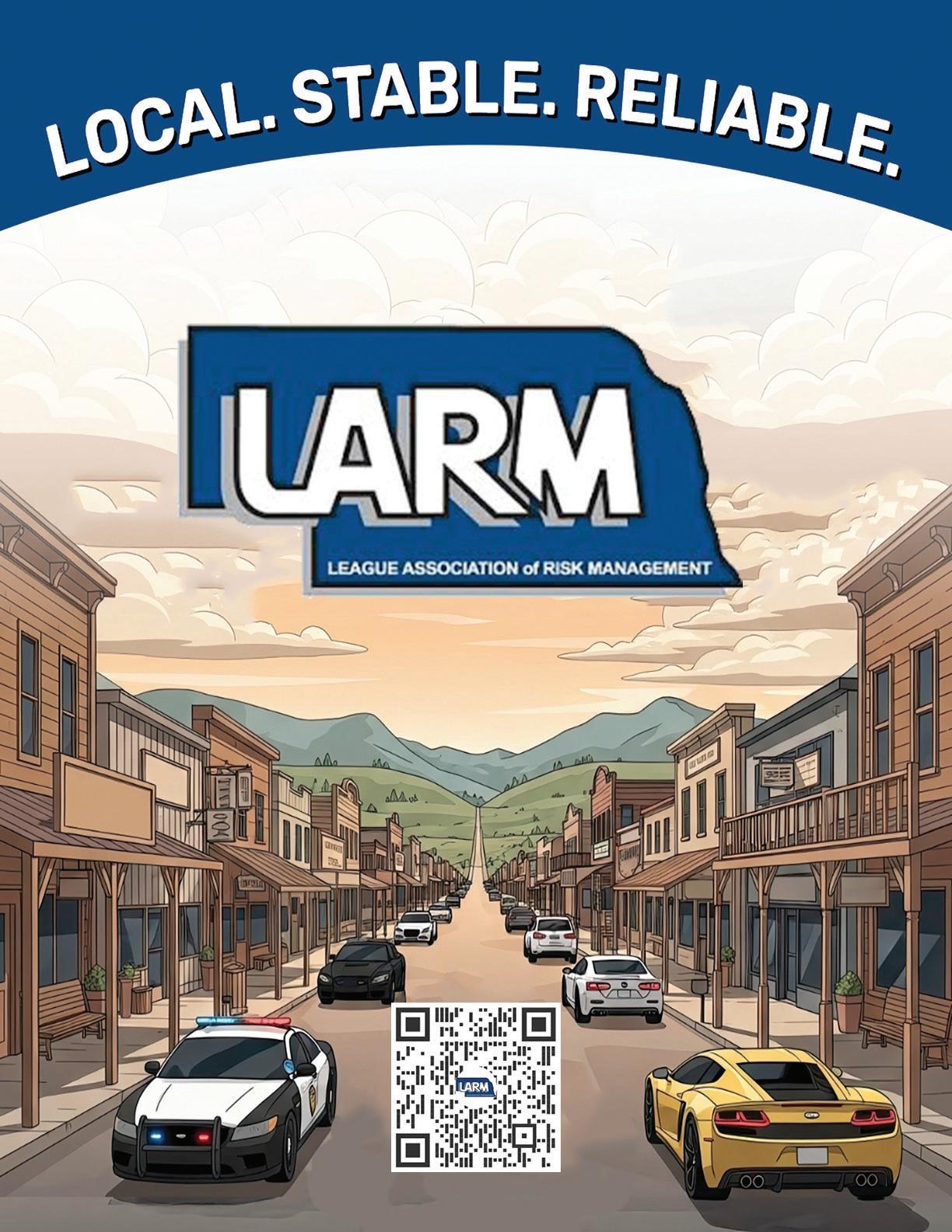WHAT’S INSIDE?
A new 2,689 sq. ft. mural has been unveiled in Blue Hill. It is full of historical gems ... some are obvious and others not so much.
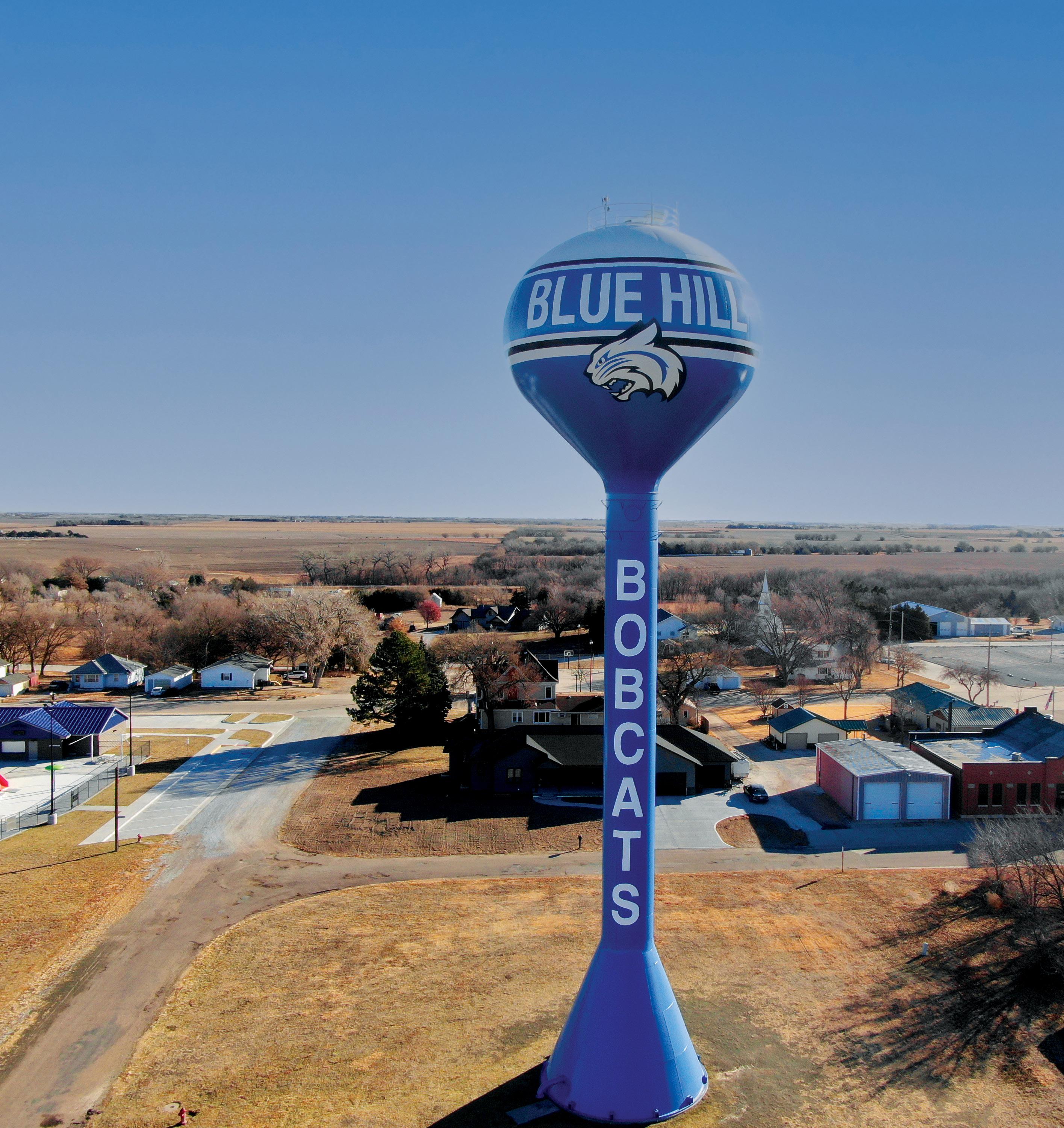
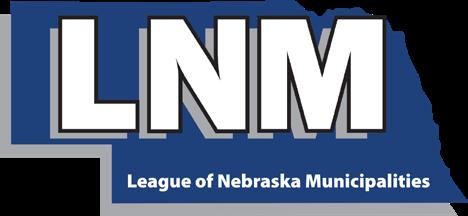


A new 2,689 sq. ft. mural has been unveiled in Blue Hill. It is full of historical gems ... some are obvious and others not so much.



The NEBRASKA MUNICIPAL REVIEW (ISSN 0028–1906) is published monthly and the official publication of the League of Nebraska Municipalities, an association of the cities and villages of Nebraska, published at 1335 L St., Lincoln, Nebraska 68508. Subscription rates are $5 per single copy — $50 plus tax for 12 issues.
Periodicals postage paid at Lincoln, Nebraska. Views of contributors, solicited or unsolicited, are their own and not to be construed as having the endorsement of the League unless specifically and explicitly stated by the publisher
The NEBRASKA MUNICIPAL REVIEW is a nonprofit publication administered and supervised by the League of Nebraska Municipalities. All revenue derived from the publication is used by the association to defray publication costs.
League of NE Municipalities staff 402-476-2829 • www.lonm.org
L. Lynn Rex, Executive Director
Christy Abraham, Legal Counsel
Lash Chaffin, Utilities Section Director
Cherie DeFreece, Admin Assistant/ Membership Services Assistant
Brenda Henning, Membership Services Assistant/ LIGHT Admin Assistant
Ethan Nguyen, LNM/LARM Information Technology Manager
Shirley Riley, Membership Services Director
Jackson Sash, Utilities Field Representative/Training Coordinator
Ashley Wolfe, Marketing/Communications Director
staff
Dave Bos, Executive Director
Tracy Juranek, Asst. Executive Director, Customer Service Specialist
Diane Becker, Communications/Marketing Director
Kyla Brockevelt, Executive Administrative Assistant
Drew Cook, Customer Service Specialist
John Hobbs, Loss Control Specialist
James Kelley, Loss Control Specialist
Fred Wiebelhaus, Loss Control/Claims Manager
POSTMASTER: SEND ADDRESS CHANGES TO NEBRASKA MUNICIPAL REVIEW, 1335 L STREET, LINCOLN, NEBRASKA 68508.
Have an idea, project or opinion to share? The League welcomes member articles, information, and op-eds.
Want to reach local decision makers? The League can help you get your message out to Nebraska’s 3,500+ municipal officials.To learn more, contact Ashley Wolfe at 402-476-2829 or ashleyw@lonm.org
President Marlin Seeman, Mayor, Aurora
President-Elect Bryan Bequette, Mayor, Nebraska City
Vice President Joey Spellerberg, Mayor, Fremont Past President Deb VanMatre, Former Mayor, Gibbon
Directors
Leirion Gaylor Baird
Mayor, Lincoln
John W. Ewing, Jr. Mayor, Omaha
Sharon Powell Village Board President, Utica
David Black Mayor, Papillion
Larry Evans Mayor, Minden
Rod Petersen Mayor, Louisville
Jim Bulkley Mayor, Columbus
Betsy Vidlak Mayor, Scottsbluff
Pat Heath City Administrator, Gering
Janine K. Schmidt
CMC/Treasurer, Morrill
Kyle Svec City Admin./Utilities Supervisor, Geneva
Affiliated Sections
City Managers
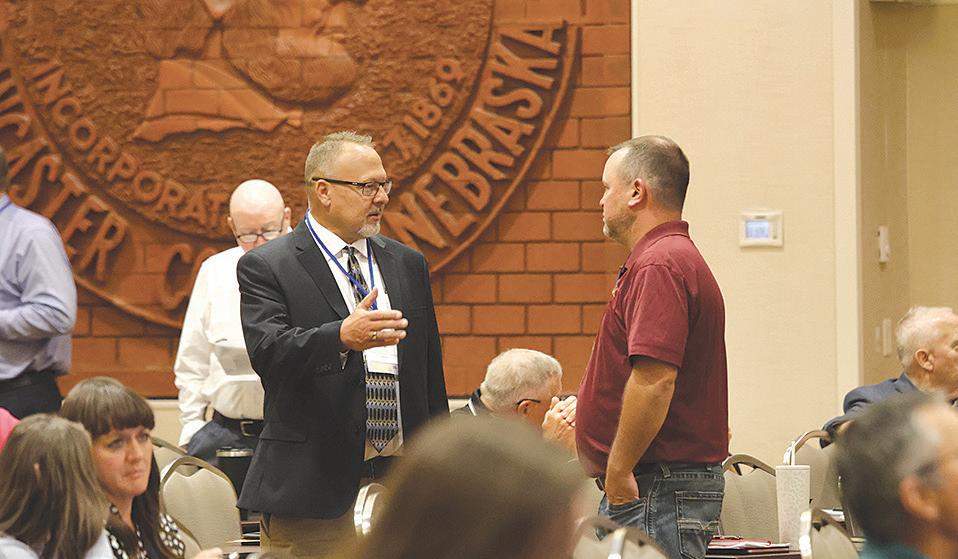
A legacy created – League honors architect Bob Ripley with Legacy Award
Dedication and a view – League conference room dedicated to Executive Director
Blue Hill: Paying tribute to heritage through art
Fremont: Historic park gets new look
AI in state and local government: Section 3 - AI policy essentials
Blair: Housing crunch solutions?
Kearney: Color & function – group uses street murals to promote peoplefriendly spaces
Lexington completes Close the Loop Trail Project
Vitality Village – Congressman Flood praising new housing division in Columbus
Ask LNM – Topic: Tax Increment Financing
6
The Director's Message - L. Lynn Rex, LNM Executive Director - League Executive Board will meet November 14 to develop the League’s Legislative Package for the 2026 session!
LARM – Workplace harassment and discrimination liabilities
Bike Walk NE: E-bikes and how to plan for them
Wes Blecke, Wayne Clerks
Munic. Accounting & Finance
Becky Erdkamp, Exeter Fire Chiefs Dennis Thompson, North Platte Utilities Pat Heath, Gering 25 26 30
Tami L. Comte, David City
The Blue Hill water tower is one of many familiar images depicted in a new mural in the community. Photo provided by the City of Blue Hill.
Chaired by Mayor Don Groesser of Ralston
John McGhehey, Mayor, Alliance
Seth Sorensen, City Manager, Alliance
Tobias Tempelmeyer, City Administrator, Beatrice
Rusty Hike, Mayor, Bellevue
Jim Ristow, City Administrator, Bellevue
Mindy Rump, Mayor, Blair
Phil Green, City Administrator, Blair
Tom Menke, City Manager, Chadron
Jim Bulkley, Mayor, Columbus
Tara Vasicek, City Administrator, Columbus
Dave Bauer, Mayor Crete
Tom Ourada City Administrator, Crete
Joey Spellerberg, Mayor, Fremont
Jody Sanders, City Administrator, Fremont
Kent Ewing, Mayor, Gering
Pat Heath, City Administrator, Gering
Roger Steel, Mayor, Grand Island
Mike Evans, Mayor, Gretna
Paula Dennison, City Administrator, Gretna
Mark Funkey, City Administrator, Hastings
James Liffrig, Mayor, Holdrege
Chris Rector, City Administrator, Holdrege
Brenda Jensen, City Manager, Kearney
Brad DeMers, Asst. City Manager, Kearney
Doug Kindig, Mayor, La Vista
Kevin Pokorny, Director of Administrative Services, La Vista
John Fagot, Mayor, Lexington
Joe Pepplitsch City Manager, Lexington
Margaret Blatchford, Assistant City Attorney, Lincoln
Riley Slezak, Senior Advisor to the Mayor, Lincoln
Linda Taylor Mayor, McCook
Nate Schneider, City Manager, McCook
Bryan Bequette, Mayor, Nebraska City
Perry Mader, City Administrator, Nebraska City
Justin Webb, Council Member, Norfolk
Scott Cordes, City Administrator, Norfolk
Brandon Kelliher, Mayor, North Platte
Layne Groseth City Administrator, North Platte
Steve Krajewski, Mayor, Ogallala
Kevin Wilkins, City Manager, Ogallala
Thomas Warren Chief of Staff, Omaha
David Black Mayor, Papillion
Amber Powers, City Administrator, Papillion
R. Paul Lambert, Mayor, Plattsmouth
Emily Bausch, City Administrator, Plattsmouth
Don Groesser Mayor, Ralston
Brian Kavanaugh, Council Member, Ralston
Jack Cheloha, City Administrator, Ralston
Art Lindberg, Mayor, Schuyler
Lora Johnson, City Administrator, Schuyler
Betsy Vidlak, Mayor, Scottsbluff
Kevin Spencer, City Manager, Scottsbluff
Joshua Eickmeier, Mayor, Seward
Greg Butcher City Administrator, Seward
Brandon Bonregard, Mayor, Sidney
Brett Kerkman, Vice-Mayor, Sidney
Lance Hedquist, City Administrator, South Sioux City
Jill Brodersen, Mayor, Wayne
Wes Blecke, City Administrator, Wayne
Barry Redfern, Mayor, York
Dr. Sue Crawford, City Administrator, York
Chaired by Tom Goulette, City Administrator of West Point
Lisa Schroedl, City Administrator/Clerk/Treasurer, Ainsworth
Jessica Quady, City Administrator, Ashland
Crystal Dunekacke, City Administrator/Economic Developer, Auburn
Marlin Seeman, Mayor, Aurora
Adam Darbo, City Administrator, Aurora
Chris Anderson, City Administrator, Central City
Andrew Lee, Admin/Clerk/Treasurer, Curtis
Tami Comte, Clerk/Treasurer, David City
Alan Michl, Chairperson, Exeter
Becky Erdkamp, Clerk/Treasurer, Exeter
Kyle Svec, City Administrator, Geneva
Matt Smallcomb, City Administrator, Gibbon
Gary Greer, City Administrator, Gothenburg
Jana Tietjen, Clerk, Hebron
Barb Straub, Admin/Clerk/Treasurer, Hemingford
Kelly Oelke, City Administrator, Hickman
Janine K. Schmidt, CMC/Treasurer, Morrill
Sandra Schendt, Clerk/Treasurer, Nelson
David Russell, Director of Gov. Affairs, NMPP Energy
Sandy Kruml, Clerk/Treasurer, Ord
Mike Feeken, Mayor, St. Paul
Sandra Foote, Council Member, Superior
Warren Myers, City Administrator, Sutton
Jessica Meyer, City Administrator, Syracuse
Kelly Adamson, City Council Member, Tekamah
Sharon Powell, Village Board President, Utica
Kyle Arganbright, Mayor, Valentine
Melissa Harrell, City Administrator, Wahoo
Desiree Soloman, City Attorney, Waterloo
Stephanie Fisher, City Administrator, Waverly
Tom Goulette, City Admin./Utility Superintendent, West Point
Randy Woldt, Utilities Superintendent, Wisner
Robert Costa, Community Planner, Yutan

(All statute citations to Revised Statutes of Nebraska)
• Each month - Clerk publishes ordinances passed within 15 days after passage. (16-405)
• Within 10 days from meeting or before next meeting (whichever is sooner) - Clerk to have minutes available for public inspection. (84-1413)
• Within 30 days from Council meeting - Clerk publishes official proceedings of meetings. (19-1102)
• Within 20 days after the end of the month - Treasurer files monthly financial report. (16-318)
• * * Clerk must prepare agenda prior to next Council meeting. (84-1411)
• By December 31- Clerk files year-end certification of street superintendent with the Nebraska Department of Transportation
• Reminder - Notice of automatic renewal of liquor and beer other than Class C licenses must be published between January 10 and January 30 of each year. (53-135.01)
• Reminder - On or before January 31 provide county assessor each new lease or changed preexisting lease which went into effect during the previous year and a listing of previously reported leases that are still in effect. (77202.11)
• Reminder - On or before January 31, each municipality with a clean energy assessment district (PACE) submits report to Urban Affairs Committee. (13-3211)
• Each month - Clerk publishes ordinances passed within 15 days after passage (17-613)
• Within 10 days from meeting or, before next meeting (whichever is sooner) Clerk to have minutes available for public inspection. (84-1413)
• Within 30 days from Governing Board meeting Clerk publishes official proceedings of meeting. (19-1102)
• Within 20 days after the end of the month Treasurer files monthly financial report. (17-606)
• * * Clerk must prepare agenda prior to next Council or Board meeting. (84-1411)
• By December 31- Clerk files year-end certification of street superintendent with the Nebraska Department of Transportation
• Reminder - Notice of automatic renewal of liquor and beer other than Class C licenses must be published between January 10 and January 30 of each year. (53-135.01)
• Reminder - On or before January 31 provide county assessor each new lease or changed preexisting lease which went into effect during the previous year and a listing of previously reported leases that are still in effect. (77-202.11)
• Reminder - On or before January 31, each municipality with a clean energy assessment district (PACE) submits report to Urban Affairs Committee. (13-3211)
LEAGUE OF NEBRASKA MUNICIPALITIES Jan. 7 - 9, 2026
23 - 25, 2026 UPCOMING

Feb. 23 - 24, 2026 June 17 - 19, 2026
BY L. LYNN REX, EXECUTIVE DIRECTOR, LNM
Thanks to the many municipal officials from across the state who took time from their busy schedules to participate in the League Annual Conference held Sept. 2426 at the Cornhusker Hotel in Lincoln! In addition to the excellent speakers and wide selection of important topics offered during the conference, the League Larger Cities Legislative Committee (LCLC) and the Smaller Cities Legislative Committee (SCLC) met concurrently before the Preconference Seminar on Sept. 24 to continue discussing requests for legislative action from member municipalities, Senators, and other organizations.
An excellent overview of the critical issues facing EMS was presented to members of the LCLC and SCLC by Micheal Dwyer , EMT, Volunteer Firefighter, and Co-Chair of the Nebraska Statewide EMS Task Force, and Dr. Eric Ernest, M.D., EMT-P, Chief of the Division of Prehospital and Emergency Medical Services, University of Nebraska Medical Center, State of Nebraska EMS Medical Director.
Dr. Ernest also serves on the Nebraska Statewide EMS Task Force with representatives from other stakeholders (including the League) advocating for a grant of $20-$25 million of the $100 million each state is guaranteed from the $50 billion federal Rural Health Transformation Program (RHTP) The goal of the RHTP is to enhance healthcare delivery systems in rural communities by improving access, quality, and outcomes through initiatives with a focus on workforce recruitment, innovative care models, and technology. Municipal officials serving on the LCLC and SCLC discussed the serious challenges in providing EMS due to a decreasing number of volunteers in many areas of the state, an increasing number of calls, and a need to address concerns of larger municipalities which can no longer afford to subsidize
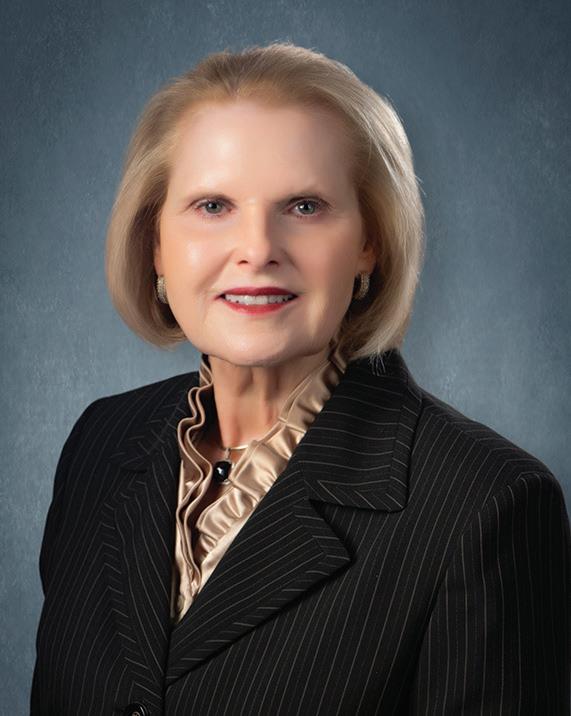
the rural areas, especially those that contribute nothing financially. City and village officials expressed strong support for this additional funding from the RHTP to help develop and finance an effective regional healthcare delivery system throughout the state.
The LCLC and SCLC also continue recommending support of other initiatives and legislative bills the League introduced and/or supported in the 2025 session which will “carryover” to the 2026 session, including: LB 115 (Sen. Ballard) to increase the income tax credit from $250 to $1,000 and change the qualification criteria under the Volunteer Emergency Responders Incentive Act; LR 16CA and LR 18CA to require the Legislature to reimburse political subdivisions for unfunded state mandates by imposing responsibility for a program or increased level of service of a current program; LB 683 to amend statutes governing the “Pink Postcard Joint Hearings” with meaningful information for taxpayers at budget hearings; and LR 19CA to increase the maximum terms of State Senators from two four-year terms to three. These are just a few of the “carryover” bills the League will continue supporting.
The LCLC and SCLC also are finalizing recommendations to the League Executive Board on over 20 new requests for legislative action on a wide variety of topics, including but not limited to: reducing a state keno tax on municipalities from 2% to 1% on keno gross proceeds; amending the Open Meetings Act to make the act more effective and the notice requirements workable, especially when a newspaper fails to publish the legal notice as requested; increasing the dollar amounts required when advertising for bids to reflect inflation since the dollar
amounts were last increased in 2008; increasing the state tax on “cash devices” (skilled gaming); allowing cities of the second class and villages to nominate and elect by ward and at large; allowing second class cities and villages to have a three-member Planning Commission instead of the five, seven, or nine members in current law; and requiring the state Fire Marshal to reimburse municipalities for duties performed. Of course, there are ongoing discussions within the League, the Attorneys Subcommittee, and other organizations regarding many other requests for legislative action, interim studies, and initiatives.
For the last few sessions, the Governor and some Senators advocated passage of legislation to repeal the county inheritance tax; the Nebraska Association of County Officials (NACO) successfully and understandably opposed these efforts without counties receiving replacement revenue. At least one Senator told the League he supports the repeal of the county inheritance tax and authorizing counties to impose a .5%, 1%, or 1.5% local option sales tax upon the same transactions INSIDE any incorporated municipality which already has a voter-approved local option sales tax! Undoubtedly, this will be a highly controversial issue in the 2026 session! Of the 528 cities and villages in Nebraska, 269 currently have voter-approved local option sales tax, many which sunset and periodically need voter approval after so many years. Section 13-319 outlines how a county must use local option sales tax imposed OUTSIDE of any incorporated municipality which has a local option sales tax; current law provides the county can only use these funds: “(1) to finance public safety services provided by a public safety commission, (2) to provide the county share of funds required under any other agreement executed under the Interlocal Cooperation Act or Joint Public Agency Act, or (3) to finance public safety services provided by the county.” The LCLC and SCLC strongly oppose any legislation that would allow counties to have a local option sales tax on the transactions in any incorporated municipality which has adopted a voter-approved local option sales tax.
Thanks to members of LCLC and SCLC listed on page 3 for committing a significant amount of time reviewing legislative requests and making recommendations to the League Executive Board. On Nov. 14, the League Executive Board will determine the League’s positions on issues of municipal concern and will formulate the League’s Legislative Package for the upcoming session. Thank you for your ongoing efforts with your State Senator(s) to discuss these important issues!
Chaired by Mayor Don Groesser of Ralston
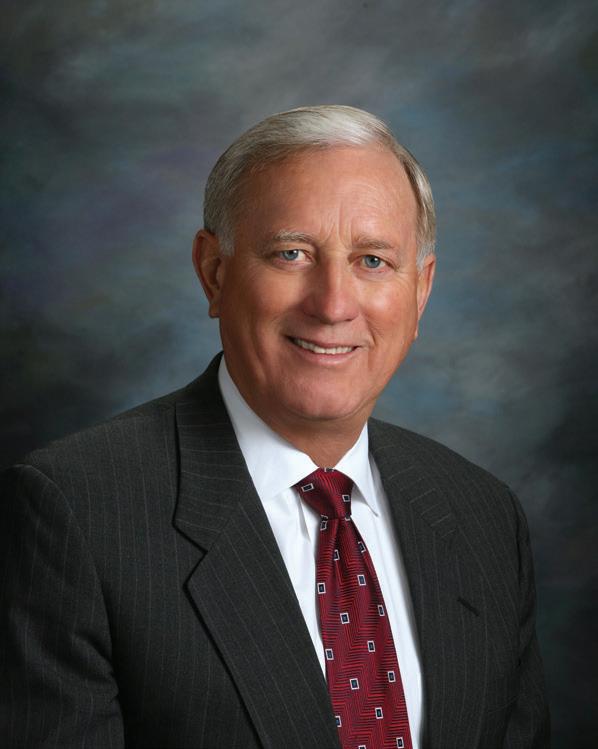
Chaired by Tom Goulette, City Administrator of West Point


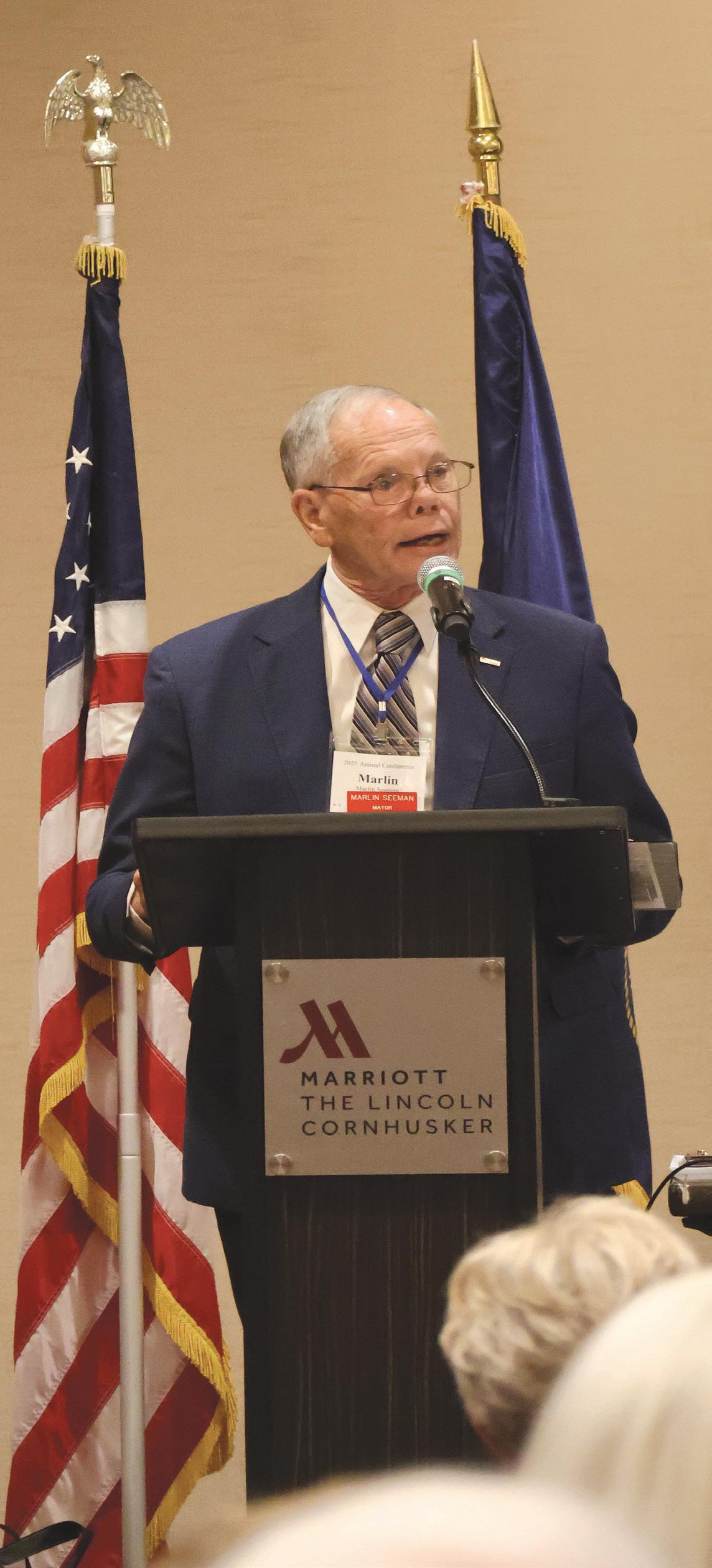
offers attendees opportunities for networking, collaboration, and learning
BY ASHLEY WOLFE, MARKETING & COMMUNICATIONS DIRECTOR, LNM
Municipal officials from across the state gathered in Lincoln for the League’s 2025 Annual Conference held Sept. 24-26 at the Cornhusker Marriott Hotel. The event kicked off with an engaging PreConference Seminar, comprised of a seven-person panel of current and former municipal officials discussing transformational zoning efforts and initiatives focused on housing and increasing economic mobility. Among the topics discussed were updating comprehensive plans, updating codes to allow businesses to more easily operate from residences, accessory dwelling units, and discussions about using LB 840 plans and micro-TIF to support community improvement efforts.
Thursday opened with a warm welcome from League Executive Board President and Mayor of Aurora,


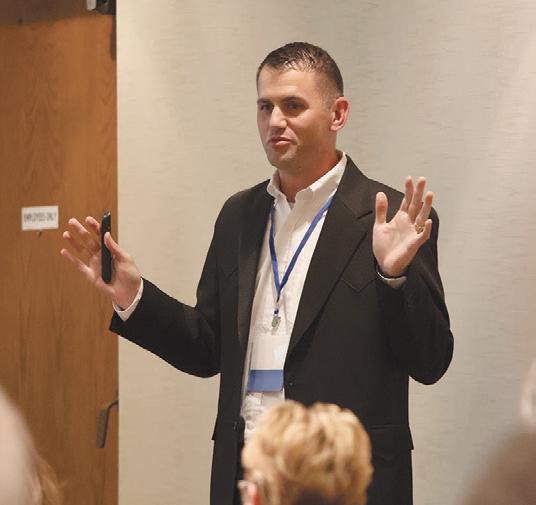

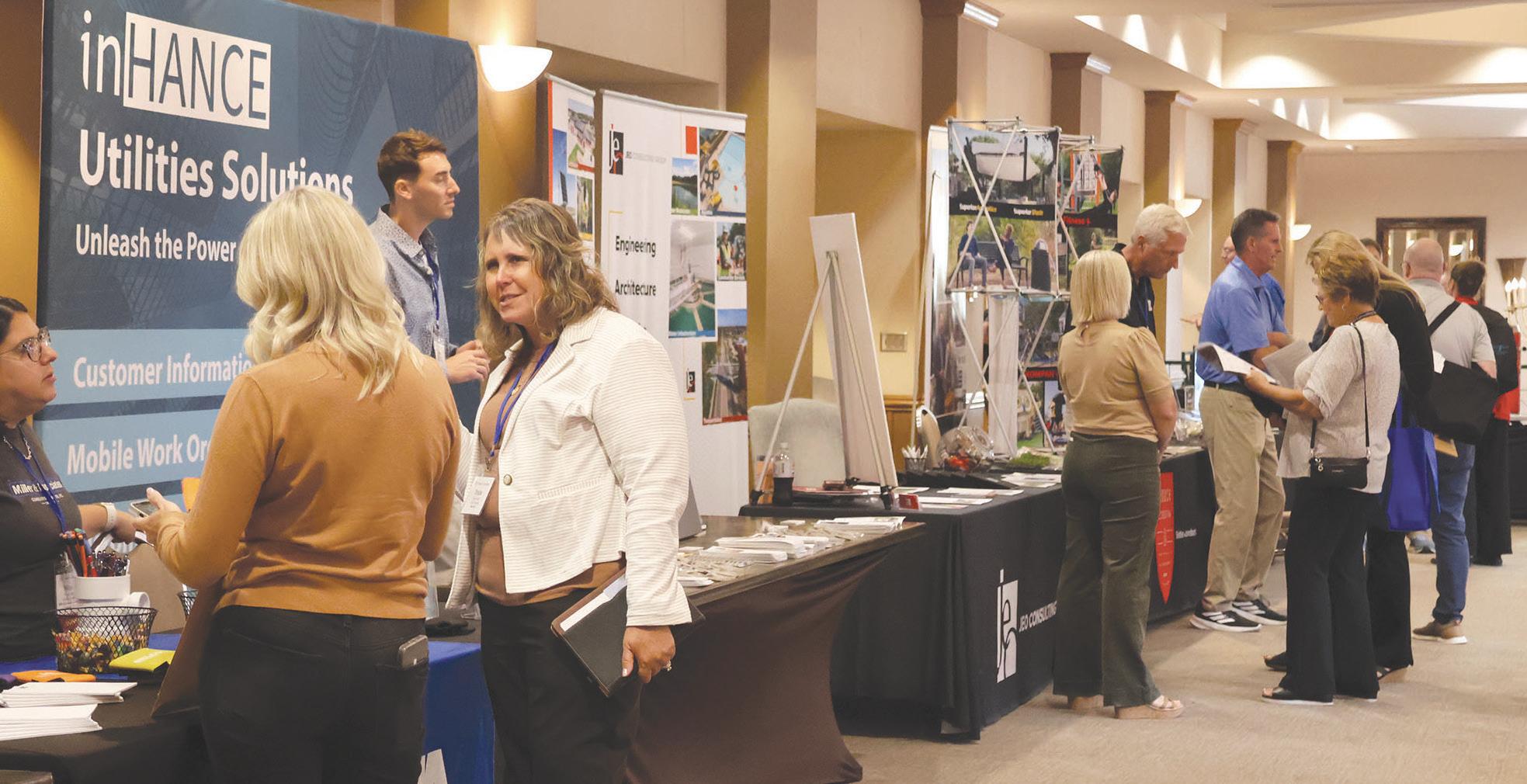
Marlin Seeman. Mayor Seeman gave special recognition to all of the firsttime conference attendees and the sponsors who allow the League to continue hosting trainings and conferences.
Brad Black, President and CEO of HumanEx Ventures, gave the keynote address and provided insight into improving the culture of an organization through intentionality in talent and people development. Black, who has had a long career working in the training space, took time to share a few takeaways on empowering individuals to be leaders in their role and in-turn, providing higher-level results as part of a team.
Craig Kubicek, Deputy Auditor with the Nebraska Auditor of Public Accounts’ Office, returned to present how to ensure each city or village has checks and balances in place to protect municipal assets. Unfortunately, there was not a shortage of stories to highlight officials and boards or municipalities getting in trouble by letting their guard down and their attention to detail lapse.
Christy Abraham, LNM Legal Counsel, and Lash Chaffin, LNM
Continued on page 8 / See Conference


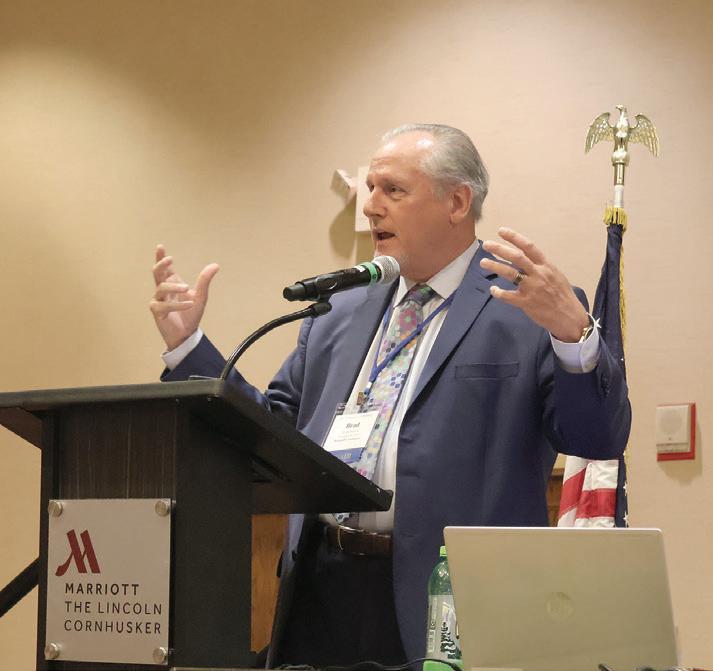

Continued from page 7
Utilities Section Director, offered a session delving into the sometimes-archaic terms and phrases used in the Legislature. Other sessions covered topics like nuisance abatement, the Engineers and Architects Regulation Act, a rundown of TIF and how to meet the Legislative requirements in the upcoming municipal budget cycle.
At the Annual Business Meeting held Sept. 26, Kyle Svec, City Administrator and Utilities Supervisor of Geneva, was elected to serve on the League Executive Board for a 3-year term as the Utility Representative. Svec replaced Layne Groseth, City Administrator and Utilities Manager of North Platte. Groseth was honored at the conference by League President Marlin Seeman and was presented a plaque thanking him for his time on the board and longstanding commitment to the mission of the League in advocating for local control.

The municipal officials serving on the LNM Executive Board are: President Marlin Seeman, Mayor of Aurora; President
Continued on page 19 / See Conference
A huge thank you to all of our conference sponsors!
• Ameritas Retirement Plans
• Black Hills Energy
BMO Bank
• Burbach Aquatics, Inc.
• Carrothers Construction Co., LLC
Clark & Enersen
CMBA Architects
• Core & Main
• Cox Communications
• Creative Sites, LLC
• Crouch Recreation, Inc.
• Cunningham Recreation/GameTime
• Cypress Engine Accessories
• D.A. Davidson & Co.
• Davis Design
• DSG Supply
• Edmunds GovTech
•Facility Advocates
FCS, A Bowman Company
• gWorks
• Hamilton Business Technologies
• IMEG
• JEO Consulting Group, Inc.
• Johnson Service Company
• LARM
• LIGHT
• Lincoln Winwater
• Miller & Associates Consulting Engineers, P.C.
• Musco Lighting
•NE Energy Federal Credit Union
• NE Investment Finance Authority (NIFA)
• NE Liquid Asset Fund (NLAF)
• NE Public Agency Investment Trust (NPAIT)
Nebraska Public Power District
• Nebraska Recycling Council
• NMPP Energy
• Northland Securities, Inc.
• Olsson
• Omaha WinWater Company
• Peopleservice
• Piper Sandler & Co.
• Polimorphic, Inc.
• PowerManager
• Precision Concrete Cutting
• Snyder & Associates, Inc.
• Sparq Data Solutions
• The Olson Group
• Twotrees Technologies
• UKG
• Union Bank and Trust
University of Nebraska - Omaha
• Vacanti Municipal Consulting Services, LLC
• Viking Industrial Painting
• Zelle Human Resource Solutions

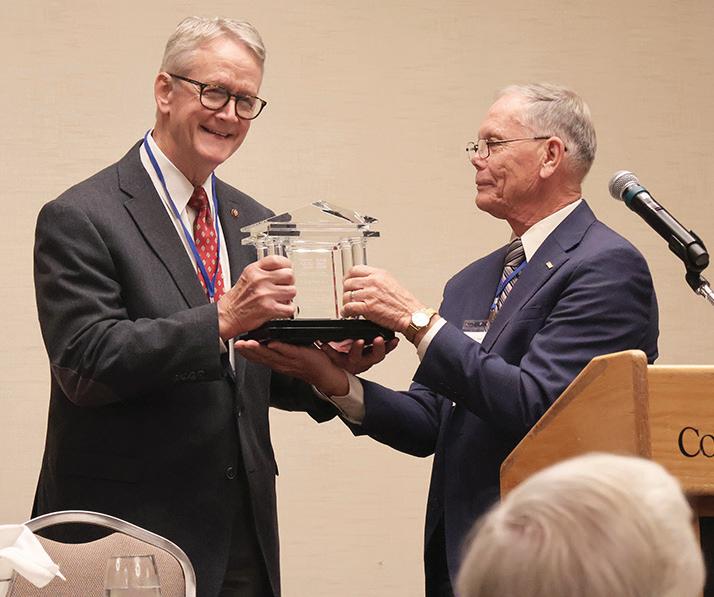
League honors architect Bob Ripley, F.A.I.A., for long career in public service, including 40 years as the State Capitol Admininstrator

Afterbeing inspired by a teacher at a young age, Bob Ripley knew where he wanted to direct his life and what his career would be.
Ripley’s passion has always been architecture and he spent more than 40 years of his career serving as the State Capitol Administrator and licensed Architect for the Office of the Nebraska Capitol Commission. At the conference luncheon on Sept. 25, Ripley was honored by the League Executive Board with the presentation of the League Legacy Award.
Ripley is the third recipient of the League Legacy Award and he joins the ranks of two other individuals who have played a key role in Nebraska history—U.S. Senator Ben Nelson and Representative Tom Osborne.
Continued on page 11 / See Ripley
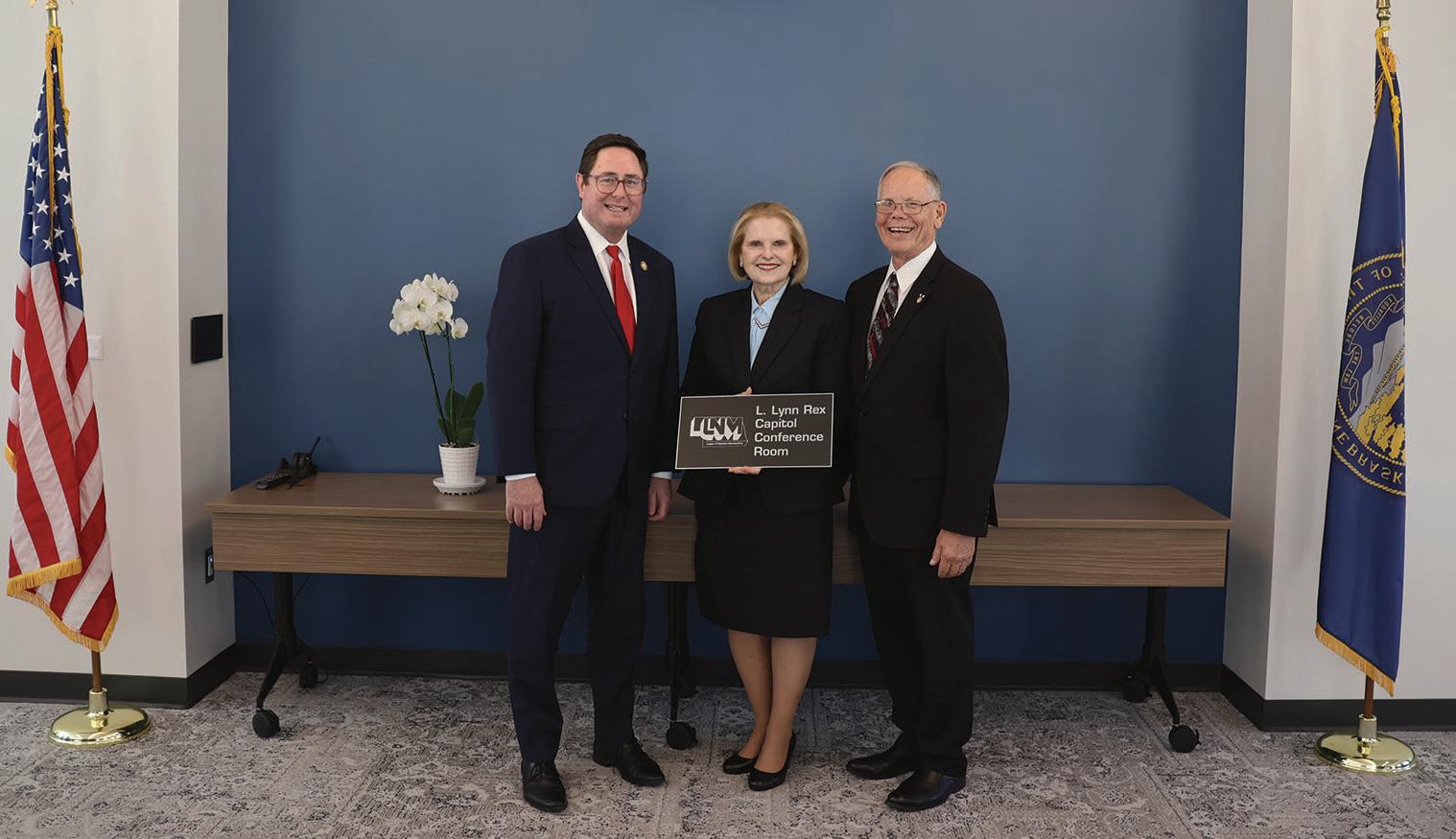
PHOTOS BY ASHLEY WOLFE, LNM
The League Executive Board voted to add the name of L. Lynn Rex to the “Capitol Conference Room” on the second floor of the new building. Following the luncheon on Sept. 26, U.S. Representative Mike Flood joined League Executive Board President Marlin Seeman in dedicating the L. Lynn Rex Capitol Conference Room.
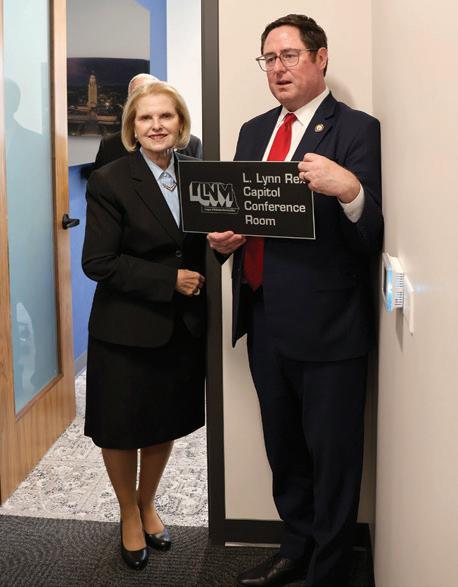


Continued from page 9
It is through Ripley’s efforts in restoring and preserving the Nebraska State Capitol that it is recognized by governors, senators and others at a state and national level on both sides of the aisle as an iconic architectural marvel.
Ripley was a key player in seeing the building designated as a National Historic Landmark in 1976. While doing research for that, his research revealed several elements from the original design plan that still needed to be complete. Ripley created the Capitol Master Plan to provide guidance and prioritization on the remaining projects.
In 1988, he led efforts to pass legislation to create the Capitol Environs Commission, a designation focused on preserving the historical nature of the 64-square-block district around the Capitol. Ripley co-authored the design standards that have maintained the view and dominance of the Capitol in the City of Lincoln’s skyline.
In 2004, Bob was appointed as the Nebraska Capitol Commission’s first Capitol Administrator. In this role, which he held until he retired, he created state rules and regulations regarding all public and private use of the Capitol building and grounds.
In 1992, Ripley created the Nebraska Capitol Collections to collect and preserve documents and artifacts from around



the world relating to the building’s original design and construction. This collection has been referred to as one of our country’s “premier historic archives.”
In addition, Ripley has authored and co-authored many publications and received many national honors relating to his lasting impact in the profession. Most notably, in 2015, Ripley became a Fellow of the American Institute of Architects. This is a prestigious honor awarded to less than 3% of the members of the American Institute of Architects throughout the country in recognition of their profound and lasting impact on architecture and elevating the profession nationally.
Thank you, Bob Ripley for your many years of service and work preserving the Nebraska State Capitol—and in turn, creating a memorable space to inspire and educate future generations of Nebraskans and visitors from all over the world.
https://bit.ly/3W7eIrD



BY ASHLEY WOLFE, MARKETING & COMMUNICATIONS DIRECTOR, LNM
In the City of Blue Hill—a vision, lots of hard work, and some patience has really paid off. The community recently unveiled a new and very large splash of color—in the form of a 2,689-square-foot mural along Main Street, but it took some time to get here.
From the 1800s through 2011, a building existed in this space. The building served as the community bank and though the bank changed names over the years, the location remained the same. In 2012, the building started to have some structural issues and the tenants moved to a new home, one a bit removed from the business district. In 2018 the dilapidated building was taken down to make room for a parking lot. But even after the lot was complete—something was still missing.
A mural committee was established and the group worked to choose an artist and theme. With the community gearing up to celebrate 150 years, that decision was simple. The mural would highlight the history of the community.
“The mural project […] reflects the city motto of preserving our
Continued on page 14 / Blue Hill



The League Insurance Government Health Team (LIGHT) helps hundreds of its members throughout Nebraska obtain affordable health insurance coverage.
With seven plan options and three networks to choose from, you’re sure to find one that meets your group’s coverage and benefit needs.
Offering your employees much-needed protection against the high cost of medical care:
• Three PPO options
• Four HSA-eligible high deductible options
• Prescription drug coverage
Single: Covers the employee only
Employee and spouse: Covers the employee and their spouse
Employee and children: Covers the employee and their eligible dependent children, but does not provide coverage for the spouse
Family: Covers the employee and eligible dependents including a spouse
RECEIVE DEDUCTIBLE AND OUT-OF-POCKET CREDIT FROM YOUR CURRENT VALID GROUP PLAN WHEN YOU SWITCH!
With several networks available, you have easy access to quality providers:
• NEtwork BLUE (Statewide)
• Premier Select BlueChoice (Regional)
• Blueprint Health (Regional)
• Out-of-state network availability
Contact your current local Agent/Broker Or contact
Dennis Maggart
Executive Vice President P: 913-378-9841 or 816-718-0335
Dennis@McInnesGroup.com
Jane Limbach Account Man ager P: 913-378-9840
Jane@McInnesGroup.com
Continued from page 12
heritage for future generations,” said Diane Karr, a member of the mural committee. “This mural will help tell our town’s story for many years to come, as well as encourage people to check out our Main Street.”
The cost of the mural was funded through local donations, grants, Keno funds, and additional city-affiliated sponsors.
Jamie Luttrell was the artist chosen to take on this huge endeavor, intended to serve as a cornerstone for the business district. In local coverage of the process, Luttrell is quoted in saying she has been painting murals for 13 years, but this is her largest yet.
The mural design committee spent a lot of time talking to people and combing through historical archives and books to decide what pieces of local lore would be highlighted in the image.
When one Google’s Blue Hill, they may stumble upon an unusual law—one from a time long ago:
“No female wearing a hat which would scare a timid person can be seen eating onions in public.”
According to articles on the law, there is little known on why this law was enacted or how and why it would be enforced—but it makes a fun and memorable tidbit for the municipality.
The mural serves to memorialize buildings from the past, along with people and all that life in Blue Hill represents.
• Bobcat (school mascot)
• Lady wearing a hat while eating an onion
• A gentleman reading the Blue Hill Leader
• Grain Elevators - symbolic of the town’s ag roots
• Old standpipe - erected in 1891 to provide water to newly laid mains. Replaced in 2001.
• Blue Hill arrow and fireworks
• Steam engine and railroad
• Country school house
• Three easter eggs
“The mural carries with it a great deal of history, which has tugged on the heart strings of many local citizens and those who have moved away,” said Susan Danehey, another member of the mural design committee.
Now that the mural is complete, the colorful rendition of Blue Hill history will serve as a backdrop for community events long into the future.
“The town’s motto is ‘preserving our heritage for future generations’ and I think this mural is a great way to do that. It incorporates all aspects of the town’s history that our children and our children’s children can reflect on every time they look at the mural,” said Blue Hill Mayor, Alex Buschow. “It truly will preserve our heritage for future generations.”
Editor’s Note: Thank you to Tricia Allen, Clerk/Treasurer of Blue Hill, for reaching out to share this story with the League.

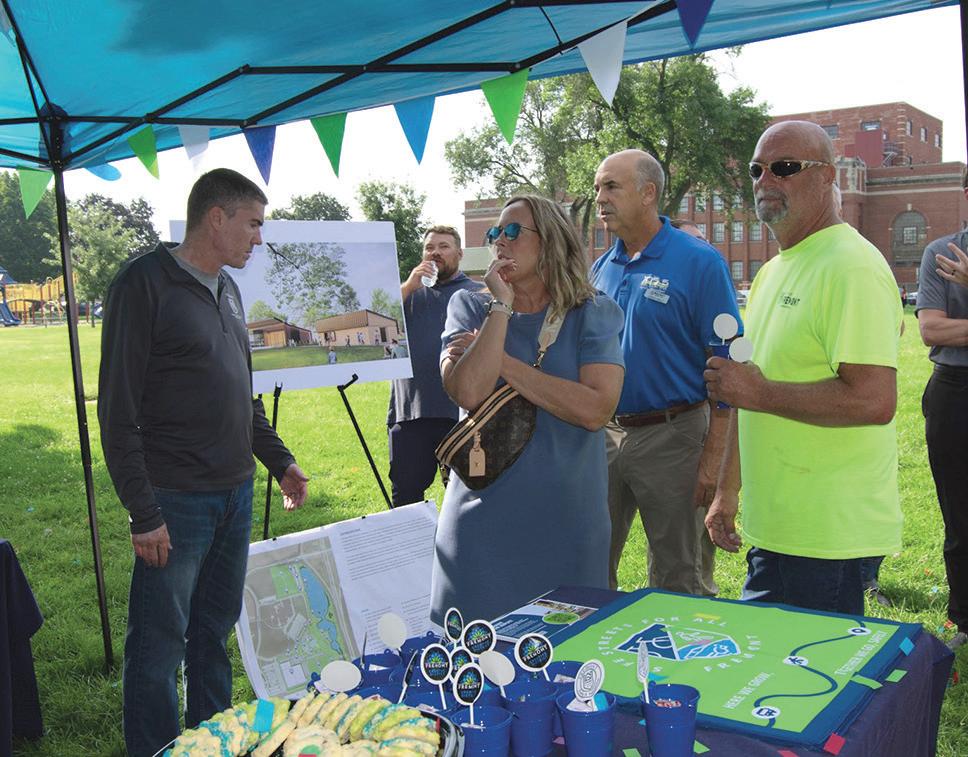
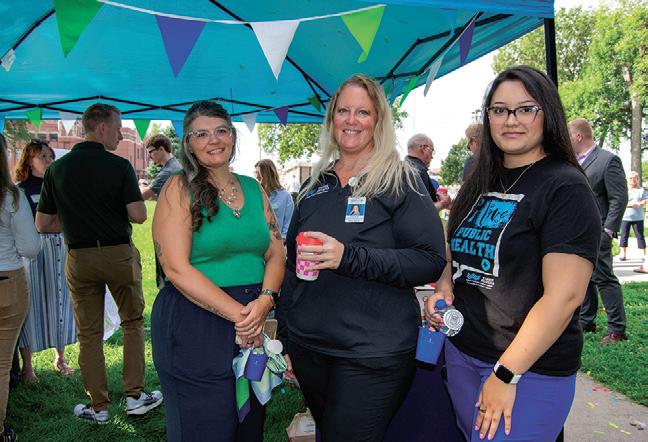

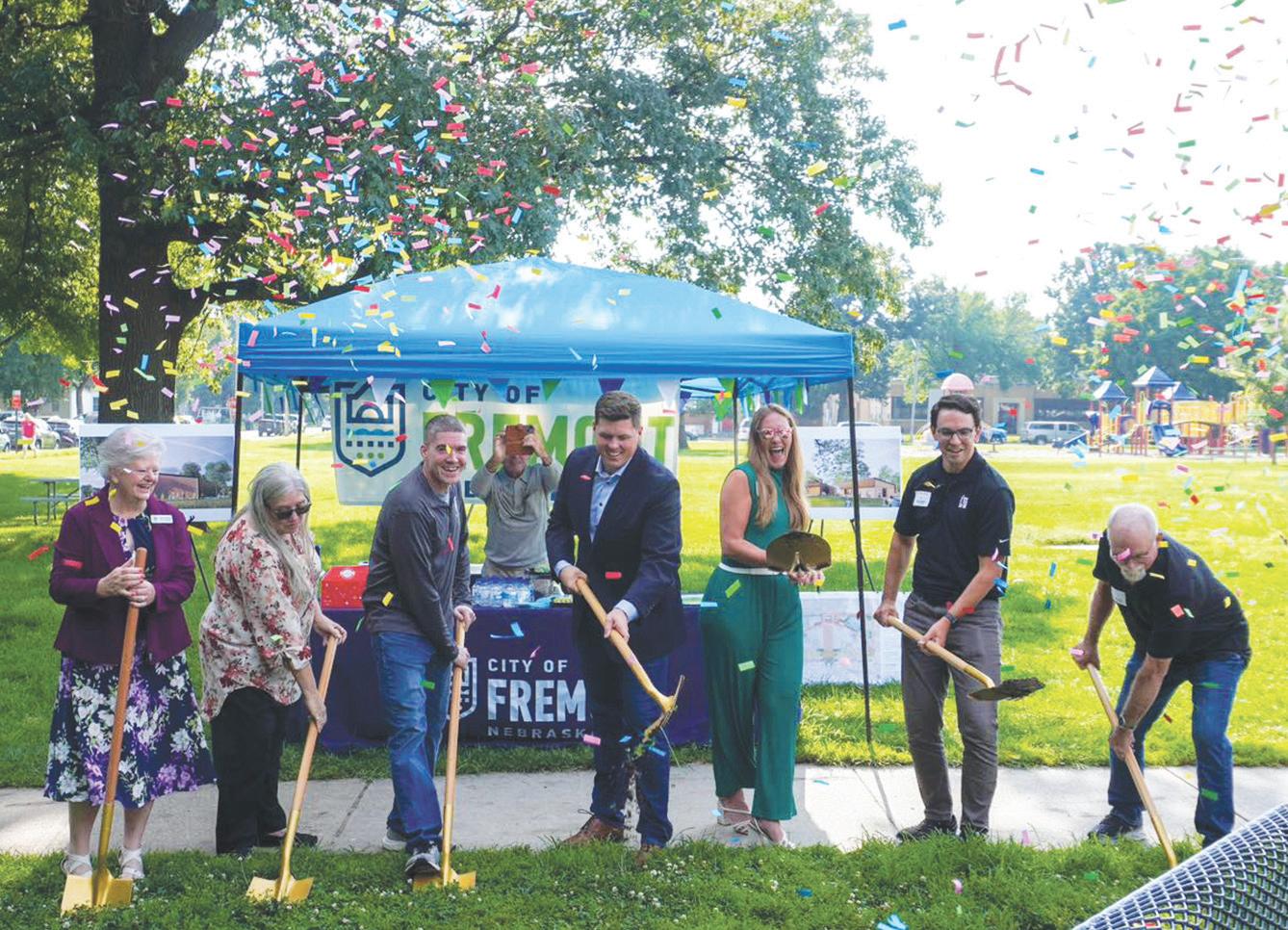
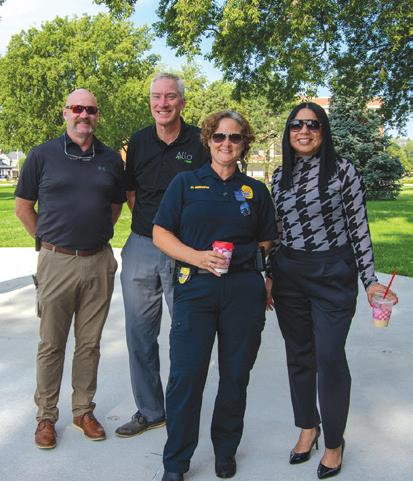

Recently, Fremont kicked off a north downtown redevelopment project. Phase 1 of John C. Fremont Park improvements began on Sept. 1. The project includes construction of an amphitheater, auxiliary building, sidewalks, and landscaping. This project is funded by a grant from the Civic and Community Center Financing Fund and is a collaborative effort between the Fremont Parks and Recreation Department and the Fremont Creative District. John C. Fremont Park, located in the heart of the city, hosts several community events and traditions throughout the year. This project was identified in Fremont’s Comprehensive Plan, Parks Master Plan, and Fremont Creative District Strategic Plan.




Section 3
Governments need a thoughtful AI policy that provides clear guidance and guardrails on ethics, fairness, data governance, and risk management. But the policy doesn’t have to be finalized before starting an AI development process. The 911 use case and the Virginia Beach StormSense project referenced in the previous section demonstrate this point. The agency leaders who championed those projects started with a specific business problem to solve. “They partnered with us, and we developed proofs of concept that have become enterprise solutions that can be shared with other agencies dealing with the same problem,” Dunn says. The agencies didn’t wait to finish AI policies before starting to innovate — they developed policies iteratively as they refined the solutions.
Developing AI policy requires a collaborative effort led by an executive champion who guides the contributions of managers in the primary IT disciplines: security, technology, data, performance, and business use cases.
“Every successful team requires a leader — a quarterback — who is accountable for results and direction,” Deshpande says. “This is especially critical as AI becomes an integral part of state operations.”
Your policy leadership team will compose an AI policy with three primary objectives:
Building trust
Users, leaders, and the public need reassurance that AI solutions are reliable and will operate as expected under specific conditions.
A thorough, effective AI policy has:
Policies should assess the likelihood of adverse AI events and anticipate the impact of these outcomes.
Preventing harm
Risk-reduction strategies should protect individuals, organizations, and the community from AI-related vulnerabilities.
• Value alignment. An AI policy must clearly state your agency’s core mission and values.
• Data privacy and governance. The policy specifies how you’ll protect personally identifiable information (PII), create data oversight to thwart breaches, and define where data gets stored, how long it’s kept, and other key issues.
• Fairness and inclusion. A policy should ensure that AI-driven outcomes do not discriminate against individuals or groups, or exclude them from apps, websites, and other digital initiatives.
• Training and education. The policy will share knowledge about the purpose, use, and impact of AI solutions.
• Accountability. The policy insists that humans have direct participation in AI-related outcomes and are held responsible for design, development, decision-making, and outcomes.
• Transparency and explainability. The policy should guarantee that you can explain how an AI solution uses data and makes decisions.
The draft of an AI policy typically has these sections:
• Executive summary. State your policy’s intent and scope.
• Definitions. Define the AI terminology, organizational roles, operational details, and other common terms that will appear throughout the document.
• Governance structure. Summarize the oversight and regulation of your AI agency’s usage and policy objectives.
• Principles and acceptable use. Describe what’s required to approve AI use cases and explain how they will be authorized.
• Data protection and security. Specify how data is managed, and spell out cybersecurity processes and protocols.
• Risk management. Identify possible adverse outcomes and state how you’ll manage and reduce risks.
• Technology acquisition. Explain how you’ll reach out to technology partners and procure AI technologies.
• Document control log. Track updates and revisions to your AI policy.
• Appendices of solutions. Multiple solutions from different technology partners may be in use. Document the details of each solution.
“Every state in the union and thousands of local government organizations are trying to develop policies and standards on their own,” McSpaden of CDG says. Working alone is one of the primary factors that can drag out the drafting of an AI policy. You can speed things up by using an existing policy as a template. For instance, the White House’s 2023 executive order on AI has all the components of a prudent AI policy.
But understand that using a template runs the risk of drafting a generic document that isn’t aligned with your AI ambitions.
The smarter route is to create a rough draft of your core AI policy principles while developing your solution, solution, and then finalize it when you’re ready to roll out the new tool. This ensures your policy applies to real-world scenarios relevant to your agency’s specific AI requirements.



BY JOHN HOBBS, LOSS CONTROL SPECIALIST, LARM
In addition to powering smartphones and gaming devices, lithium batteries now power everything from leaf blowers and lawn mowers to cars and home appliances. These batteries are getting larger in capacity and becoming less expensive, allowing them to be used in thousands of devices for a very low cost. With this widespread use comes a significant challenge: improperly disposing of lithium batteries poses serious fire and explosion risks. Lithium batteries have been known to ignite and even explode when damaged, over-charged, or exposed to extreme temperatures. Items with lithium batteries that have been water damaged are particularly prone to malfunctioning. Those in the waste disposal industry are especially at risk. When lithium batteries are crushed or punctured during waste processing, they can ignite, causing significant fires in recycling facilities and garbage trucks and possible injury to sanitation workers.
Fires from lithium batteries are already being reported regularly at landfills throughout the state. Many municipalities that handle waste before it is transferred to

larger processing facilities have a significant risk of property loss or injury from the storage of discarded lithium batteries. Here are some ways to reduce the incidence of injury or loss from discarded lithium batteries:
• Because of the possibility of fires starting from lithium batteries that have been improperly disposed of or damaged in other ways, do not store trash from public sources inside or near a building.
• Educate employees and community members on the wide array of devices that contain lithium batteries and the danger of disposing of them incorrectly. (Lithium battery information sheets are available at nfpa.org.)
• Contact a local waste management company to see if they would accept lithium batteries from a community collection location.
• Inform community members on locations where and how these devices/batteries can be safely disposed of.
• Organize a lithium battery collection event for your community.
LARM has created an informational flyer about proper lithium battery disposal that can be displayed and distributed to community members. This resource is available on our website. Some Keep Nebraska Beautiful Affiliates have partnered with communities to provide lithium battery drop-off locations. Communities can apply for environmental grants to dispose of lithium batteries. LARM offers a safety grant to members to help purchase storage containers and fire suppressant materials for lithium batteries. Go to larmpool.org for more information.

America'scities remain strong in 2025, even as local leaders face rising costs, workforce shortages, and decreased federal support. The National League of Cities' 2025 State of the Cities report highlights mayors' top priorities this year: economic development, infrastructure, budgeting, housing, and public health and safety.
Mayors are focusing on attracting businesses, investing in workforce development, and revitalizing downtowns. At the same time, they are grappling with aging infrastructure, housing shortages, and the end of major federal funding programs like ARPA. Mental health, substance use, and cybersecurity also remain top concerns. Despite these challenges, the report shows local leaders are innovating and adapting--finding creative solutions and calling for stronger federal-local partnerships to sustain momentum. Download the report at nlc.org/resource/stateof-the-cities-2025/.
Continued from page 8
Elect Bryan Bequette, Mayor of Nebraska City; Vice-President Joey Spellerberg, Mayor of Fremont; Immediate Past President Deb VanMatre, Former Mayor of Gibbon; Leirion Gaylor Baird, Mayor of Lincoln; John Ewing Jr., Mayor of Omaha; Sharon Powell, Village Board President of Utica; David Black, Mayor of Papillion; Larry Evans, Mayor of Minden; Rod Petersen, Mayor of Louisville; Jim Bulkley, Mayor of Columbus; Betsy Vidlak, Mayor of Scottsbluff; Pat Heath, City Administrator of Gering (as the Manager/Administrator Representative); Janine Schmidt, CMC/Treasurer of Morrill (as the Clerks Representative); and Kyle Svec, City Administrator/Utilities Supervisor of Geneva (as the Utility Representative).
Following adjournment of the conference, the League Executive Board and staff invited everyone back for a lunch and tour of the new League building. A highlight for many visitors was seeing if they could identify municipalities highlighted in the many photo canvases lining many of the walls in the new space. The new building has been a project many years in the making and will better serve the needs of member municipalities of the League, Utilities Section, LARM, and LIGHT for many years to come. Thank you to everyone who had any part in the building process and a special thanks to those who took time to join us before heading home.


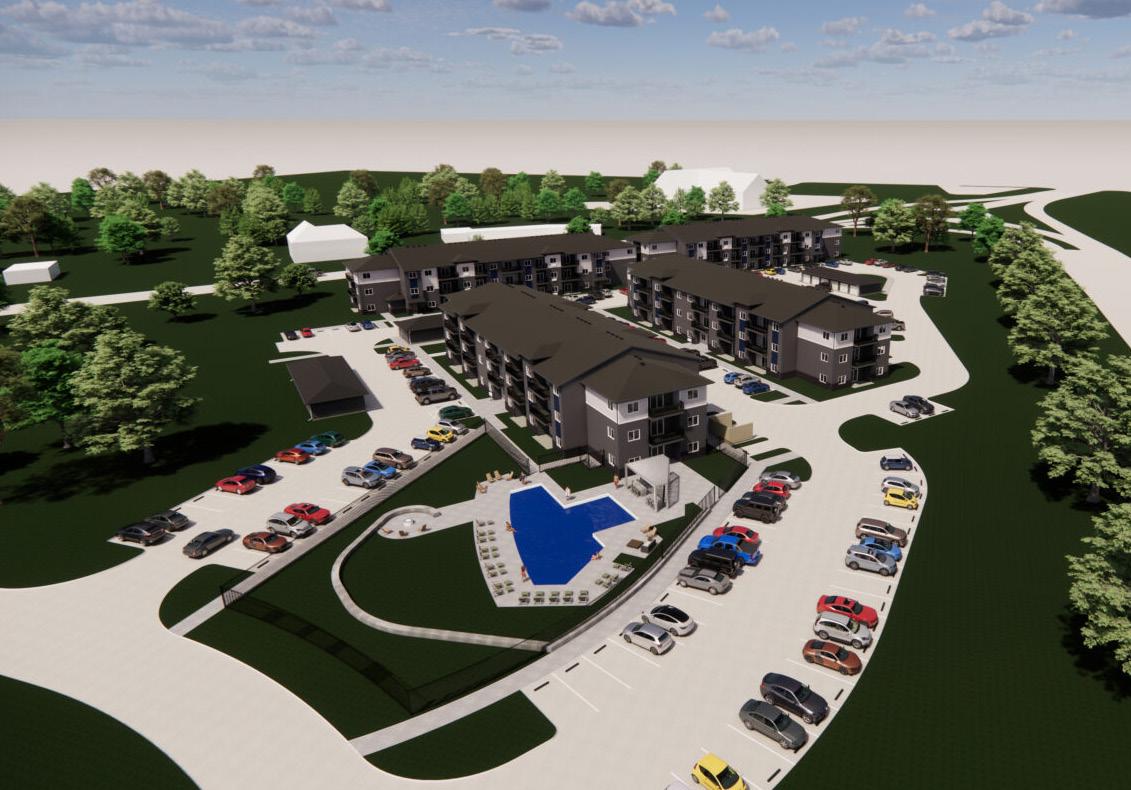
BY CINDY GONZALEZ, NEBRASKA EXAMINER
Blair is about to get its first new major apartment complex in a quartercentury — a 132-unit market rate project the public is chipping in for to help boost business and growth in the town a half hour north of Omaha.
Real estate developer Metonic broke ground earlier this month on the $27 million Blair Crossing Apartments, which will feature amenities including a fitness center, dog park, and resort-style swimming pool.
Public incentives helping to defray costs include $300,000 in local tax revenue from the city’s “LB 840” program and up to $2.03 million in tax-increment financing (TIF). TIF allows property tax revenue from new improvements at the project site to pay for eligible expenses of development.
The city of about 8,000 residents also pledged $2.4 million for area public road and infrastructure improvements that City Administrator Phil Green said not only will benefit apartment access but also should ignite surrounding commercial growth that bumps up property and sales tax revenues.
“We’re hoping that this Blair Crossing development becomes the kickstarter to see even more development in that area,” said Green. “Invest a little now, so you get a bigger payoff down the road.”

We’re hoping that this Blair Crossing development becomes the kickstarter to see even more development [...] Invest a little now, so you get a bigger payoff down the road.
It’s part of a strategy to increase housing options in a town whose job base has expanded but where further growth is threatened by limited and aging housing availability. Blair is among communities across Nebraska exploring ways to address housing affordability and supply, a challenge that a statewide report said had reached crisis proportions.
Mike Rooks, executive director of Gateway Development Corp., which is the economic development arm of Washington County, said Blair businesses have struggled to recruit workers amid a housing crunch.
He believes the shortage also has discouraged some companies from opening or relocating there.
“The CEO will look at me and say, ‘Where are my employees going to live?’” said Rooks. “So this is another tool in our toolbox that we can show.”
Currently, Rooks said, about 3,500 Omahans drive to Blair to work, and about 2,000 Blair residents drive to Omaha to work.
At Blair’s expanding bioscience campus, more than 60% of employees commute there to work, officials said. The campus includes companies such as Cargill, Corbion, Novonesis (formerly Novozymes), NatureWorks and Evonic.
Meanwhile, over the past four years, Blair has seen more than $500 million in capital investment, Rooks said. That includes a Dollar General distribution center officials say employs nearly 700 people. Just last month, a new $100 million Calcium Products project was announced.
Calcium Products, an agricultural technology company specializing in pelletized high-calcium lime and gypsum, bought 113 acres in Blair South Industrial Park to construct two new production facilities. The project is to create about 50 new full-time jobs when scheduled to open next year and also will spur a new railyard that’s expected to lure additional industrialfocused business.
Rooks expects the Blair Crossing Apartments to be “gobbled up” when they are scheduled to open in 2026. He and Green said Blair hasn’t had a newly built major apartment building since around 2000.

The project site near Nebraska Highway 133 and U.S. 30. Photo courtesy of Metonic.
Engineering a world where everyone thrives.


D.A. Davidson & Co. is committed to strengthening the infrastructure and enriching the lives of people in our communities throughout Nebraska and across the nation.
Our bankers specialize in:
• Bond Anticipation Notes
• Paving Bonds
• Water and Sewage Bonds
• General Obligation Bonds
• Utility System Revenue Bonds
• Lease-Purchase Financing
Call:
(402) 392-7986 | Paul Greiger (402) 392-7989 | Cody Wickham (402) 392-7988 | Andy Forney (402) 392-7933 | Jerry Spethman


Metonic developers said that about 67% of the Blair housing stock was built prior to 1990, so Blair Crossing will offer a contemporary living option. The residences should be attractive to Omaha workers as well, Rooks said, offering a modern small-town living option a short drive from the amenities of a bigger city.
He said a 2021 study of Blair and five smaller Washington County municipalities foresaw a demand for more than 500 new housing units by this year. They haven’t “even scratched the surface,” said Rooks.

The four-building, three-level Blair Crossing complex is rising on roughly six acres at the convergence of U.S. 30 and Nebraska Highway 133. Dwellings will range in size from studio apartments to three-bedroom units, with rents likely to run from $1,200 to $2,000.
Metonic President Kassie Inness said in a statement that she felt strong local support for the project and has not seen anyone stand up in opposition. “That is almost unheard of in multifamily development,” Inness said.
Metonic partners include general contractor Ronco Construction, Ruff Grading, TRB Architecture, Lamp Rynearson, and Veridian Credit Union.
Rooks said Blair public officials have come to believe that the city “has to step up” with public incentives in order for real estate developers to invest there. A housing advisory committee appointed by Blair Mayor Mindy Rump has recommended various approaches to help bring housing of different styles and prices to the area.
The $300,000 in “LB 840” funds for Blair Crossing was possible via Nebraska’s Local Option Municipal Economic Development Act. That law allows cities, given local voter approval, to use local tax revenue for economic development, including housing initiatives.
In Blair’s case, voters first gave the green light in 2006 to use a portion of the local sales tax for an LB 840 program, and last year reauthorized a program for 12 more years.
Green said the city also agreed to cover $2.4 million of a $3.2 million cost, with the rest paid by developer Metonic, to improve access and highway connections around the apartment complex.
He said the project site and surrounding land had remained undeveloped largely because of costly changes needed to link the area to major roadways.
Green said a recommendation from the city’s housing advisory panel encouraged use of incentives to help make land more alluring for development.
TIF is an economic development tool authorized decades ago by the Nebraska Legislature, though it has become increasingly controversial. City Councils, following a public hearing process, must give thumbs up or down for each TIF project.
Critics, including some lawmakers, say TIF in some cases has been used too generously and perhaps on projects that a developer might have undertaken without the incentive. Part of the concern is that the new property tax collected on the improved portion of a project site is redirected, for up to 20 years, to help pay off development expenses rather than being sent to traditional recipients such as schools and local governments.
After that TIF period of 15 to 20 years, all property tax at the site flows to the traditional recipients.
Rooks said public incentives have become increasingly important for smaller Nebraska communities like Blair.
“We have to show incentives and we have to show them why they need to come here,” he said.
See the Nebraska Examiner at https://nebraskaexaminer.com/
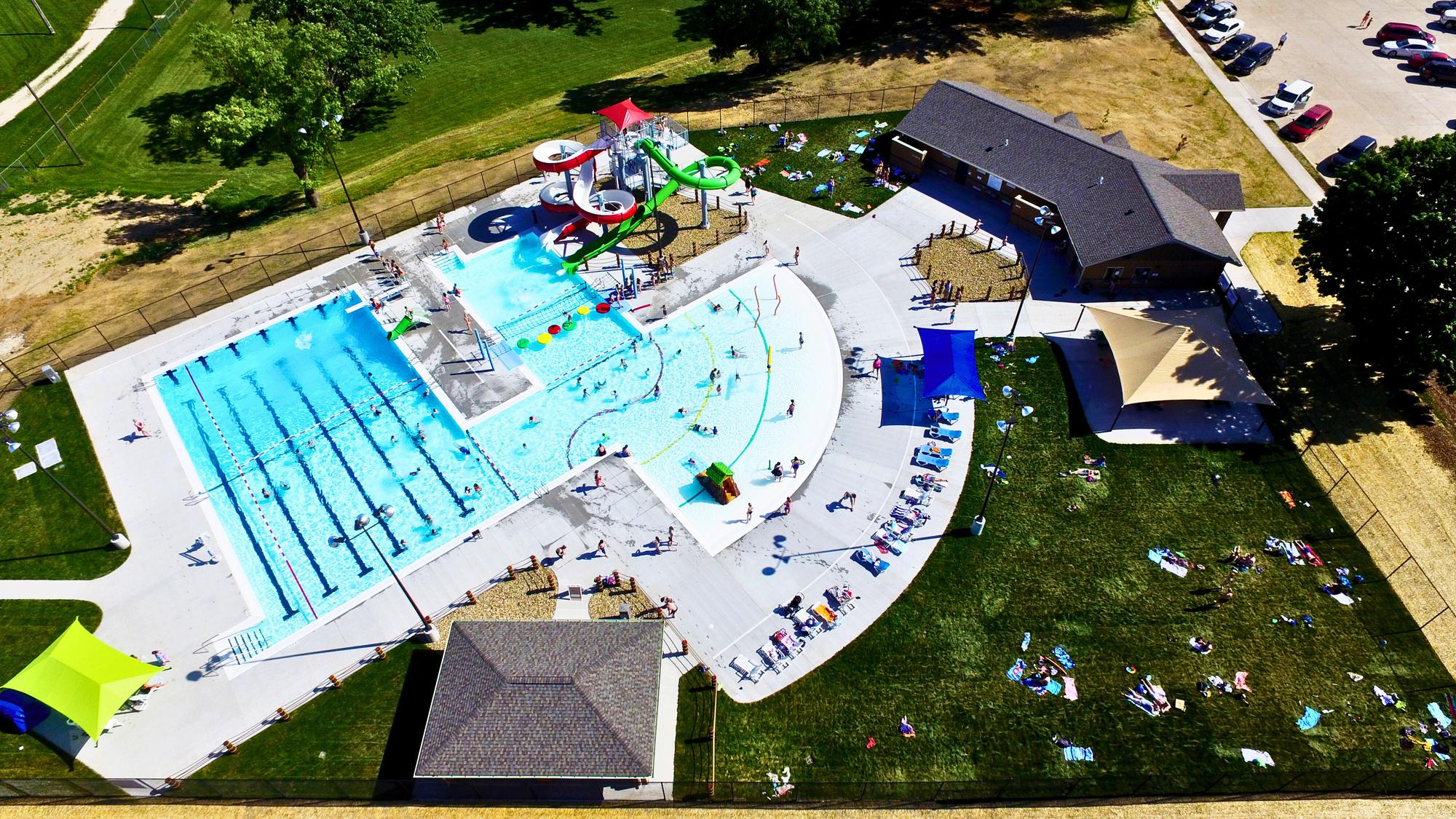
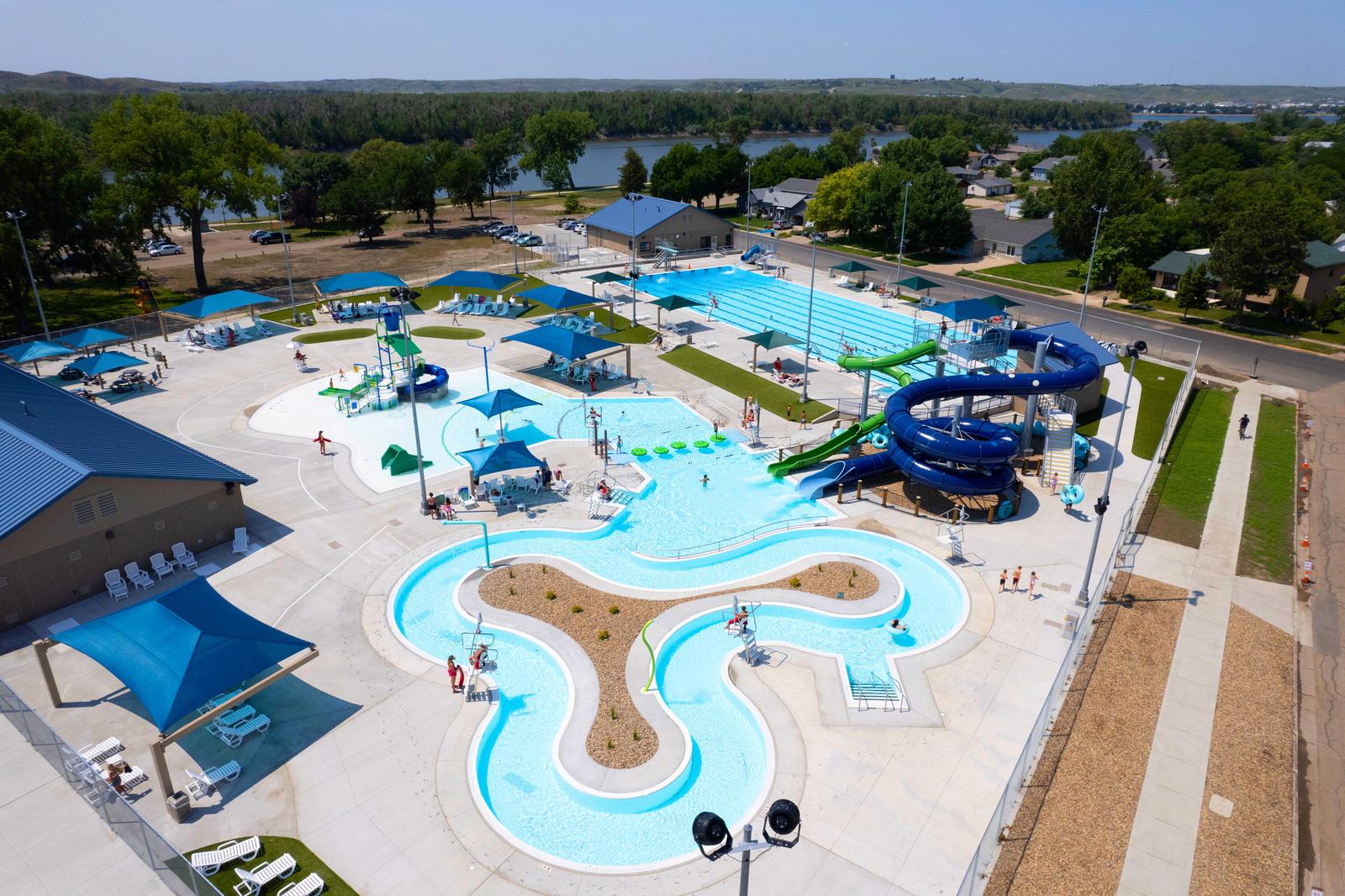



In July, Kearney for People-Oriented Places (KPOP) took to the streets to paint a temporary street mural at the corner of 5th Avenue and 29th Street in Kearney. The project was held in conjunction with Art in the Park and aimed to show the impact of traffic calming by taking a car-dominated street and turning it into a more vibrant and people-friendly space. The project was supported by Kearney Arts Guild and the City of Kearney. KPOP is a local organization focused on finding simple solutions to creating a safer, people-oriented city. KPOP organizer, Jakob Vohnout Larchick, said the organization is already planning additional murals for next year!






The City of Lexington recently announced the completion of the Close the Loop Trail Project with four non-contiguous segments of new hike-bike trail in the community. According to the City newsletter, there has already been a noticeable uptick in trail usage in the area. The trail project was made possible by the Recreational Trails Project (RTP) grant administered by the Nebraska Game and Parks Commission. The NGPC awarded Lexington $250,000 to build a 10- foot-wide, 4,368-footlong concrete trail in four segments to close gaps in existing community trails.
Additionally, thanks to the Trees for Nebraska Towns Initiative (TNT), an effort of the Nebraska Statewide Arboretum and the Nebraska Forest Service, the City of Lexington received ten free trees to enhance the Close the Loop Trail Project.


Continued on page 29 / See Trees

‘This is what a solution looks like’: Congressman Mike Flood praises new housing division in Columbus
STORY PROVIDED BY THE CITY OF COLUMBUS
Congressman Mike Flood’s recent visit to Vitality Village carried a personal touchit’s just blocks away from where his wife, Mandi, spent her childhood.
“She was on 6th Street, a couple blocks down from Casey’s,” Flood said during his Monday, Aug. 11 visit. “She was a little girl running up and down 6th Street. This was a very happy neighborhood for her.”
Flood (R-Norfolk) came to Columbus to get a firsthand look at Vitality Village, the City’s ambitious housing subdivision being constructed to help address local needs.
The City of Columbus, with approval from
the Columbus City Council, announced in August 2023 plans to take $1 million out of its discretionary funds and $1 million from utility funds in the fiscal year 2023–2024 budget to put toward the workforce housing subdivision along 8th Street.
The City purchased the land and is installing all initial infrastructure with the goal of developing a vibrant housing community tailored to the local workforce. The lots are sold to developers to ease their up-front burden and incentivize construction. These invested funds will be paid back as the lots sell and property taxes are collected on the developments.
Flood said he was already excited when he heard about the housing development while in Washington, but seeing it in person, especially coming over the 3rd Avenue viaduct, increased those feelings.
“This is what a solution looks like. It’s very impressive,” Flood said as he watched construction crews working on the apartment complex and townhomes nearby. “There are a lot of towns in Nebraska that would want something like this, especially being two blocks from an elementary school, the arterial road with a walking trail, the park, the fire station.”
Flood has been known for championing Columbus at the nation’s capital, including the city’s Vitality Village project. In fact, back in March 2025 he invited City Administrator Tara Vasicek to speak on housing and the City’s efforts with Vitality Village during the Housing & Insurance Subcommittee for the Housing Financial Services Committee.
“He said when I was in D.C. that he was going to make a trip to Columbus to come and see Vitality Village, so I’m excited that he gets to see it,” Vasicek said.
Vasicek and Mayor Jim Bulkley on Monday afternoon met with Flood outside the subdivision on 8th Street to give him a rundown on how the idea came together, how it was budgeted and what progress has been made so far.
“You know, he (Congressman Flood) has been very involved as we’ve looked for alternative things to do for our housing issues,” Mayor Bulkley said. “Our city administrator made a trip to Washington at his request to talk about what we’re doing and how it’s working, so that’s why he’s here today. He wants to see those results in person.”
The mayor said he’s proud of what the City has been accomplishing in recent years, particularly with Vitality Village.
“There has been a lot of talk about it, and a lot of work put into it,” Bulkley said. “It’s coming along really well. I’m excited to see all of it.”
Mayor Bulkley also praised Flood for his continued support of Columbus through various initiatives.
“There are a lot of towns in Nebraska that would want something like this, especially being two blocks from an elementary school, the arterial road with a walking trail, the park, the fire station.
“He’s really good at opening up and saying, ‘What’s going on and how can I help you?’ Obviously, he doesn’t always have the answer immediately, but he takes good notes and once he gets your comment in his notebook, he will always follow up on it. So, he has just been a good ally for Columbus.”
Prior to stopping at Vitality Village, Flood visited the Columbus Police Department. Known for his avid support of first responders, he had not yet had an opportunity to tour the facility. Needless to say, he was pleased after meeting with officers and touring the department.
“What an upgrade,” Flood said. “When I walked in there, they had police officers from all across the state for training. Just think of the value that brings to Columbus. You have those relationships with officers all over the state, which helps keep people safe, solve crimes and build partnerships with other agencies. I enjoyed (my visit).”
As Flood wrapped up his conversation with Mayor Bulkley and Vasicek, he once more looked over at the townhomes and apartment complex being built just west of the Charlie Louis Fire Station.
“This is proof that what’s going on here in Columbus is working,” he surmised.
The congressman concluded by mentioning that his wife would enjoy hearing about her old stomping grounds.
“I’m going to tell her how they’re building in her old neighborhood when I see her tonight,” he said, smiling. “She has great memories of growing up here.”

E-bikes are booming, and we’re in the process of collecting the best standards and practices on how to navigate them as a community, land manager, or trail association.
BY JULIE HARRIS, EXECUTIVE DIRECTOR, BIKE WALK NEBRASKA
Fall is finally here, and kids are back in school. We’ve all managed to survive the biannual chaos that comes at either end of the school year: schedules change, priorities change, and even the traffic patterns change.
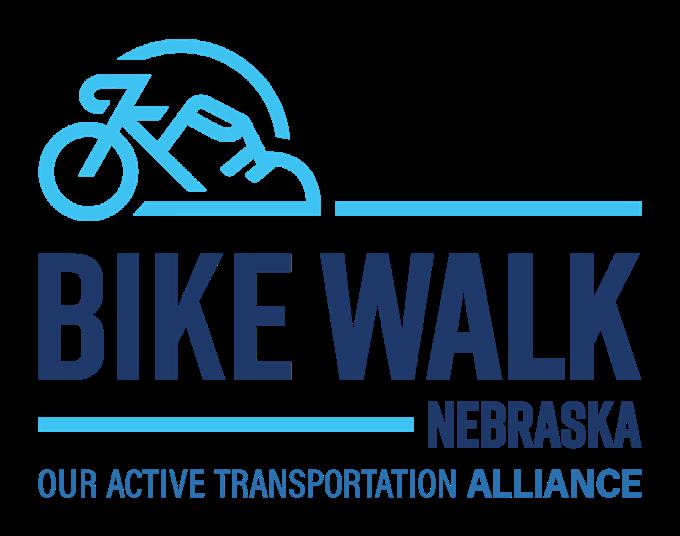
One very noticeable change I encountered this year when school was dismissed for summer, was the sudden proliferation of electronic devices people (especially kids) were using on the sidewalks, trails, and streets. I’m not talking about electric devices, as in phones; I’m talking about electric mobility devices, as in scooters, skateboards, bicycles, golf carts, and ATVs in every shape, size, and speed.
Seeing kids zooming around at higher speeds than expected quickly caught the attention of this bike and pedestrian advocate. I found myself squinting a lot: “Is that an ebike? Are there even pedals on that thing? Wait, is that a moped? I’m sorry, but WHAT IS THAT?”
Trust me, I wasn’t the only one. The level of conversation in my professional circles became increasingly dominated by this topic of conversation. The group chats were busy.
It wasn’t long before social media weighed in with the hot takes and complaints. In one corner, we had the “Let kids be kids! At least they aren’t inside playing video games all day” contingent; in the other corner, we had folks with legitimate concerns about safety and proposals to ban all electric-powered mobility devices from trails altogether. Or maybe impose a speed limit. Or maybe allow certain devices but not others? Or drawing the line at watts?… or horsepower? Or speed capacity?
The market for these types of e-devices is booming. It’s like the market is someone on a fully charged, souped-up moped and the policy is someone with one untied shoe trying to walk a little faster in an effort to catch up. We’re in a tough spot right now. Here’s the deal: the proliferation of devices is here to stay, and we need to find a balance between freedom of mobility and safety. Writing policy from a knee-jerk reaction stance won’t get us there. Creating ordinances with no practical enforcement mechanism might make us feel better, but it won’t solve the challenges. We can’t ban certain types of mobility devices from trails or sidewalks and then also not provide the infrastructure that makes it safe to use them on the street.
Nebraska also needs to invest in the types of recreation that people are asking for. The Nebraska Game and Parks Commission surveys its citizens every four years, asking what types of recreational amenities folks would most like to see in state parks so that they can update the State Comprehensive Outdoor Recreation Plan. Trails are the most popular every time this survey is given.
Bike Walk Nebraska is working to convene advocates, decision-makers, land managers, and trail managers with the goal of finding common ground and good policy that works for Nebraska. You can help us by staying in touch with us about what you’re seeing in your community, the concerns you have, and the questions you are fielding. Together, we can find the sweet spot that maximizes safety while preserving freedom of mobility. We invite you to join the conversation by emailing your thoughts to info@bikewalknebraska.org, visiting our website at www.bikewalknebraska.org, and staying connected with us on social media.
Continued from page 25
For the planting of the trees, the City partnered with Lexington High School to provide hands-on training. Thirteen students were provided a brief how-to session, before jumping in to plant the remaining trees.
The TNT program goals are not just to plant more trees, but also to increase appreciation and awareness of the significant value of community forests in Nebraska. Special emphasis
Governor Pillen signs executive order launching Good Life, Great Careers Initiative
Governor Jim Pillen signed an executive order at Northeast Community College launching the Good Life, Great Careers Initiative as part of Manufacturing Month in Nebraska. The new initiative aims to establish clear pathways for Nebraskans, especially youth, to access thriving and stable careers.
“Apprenticeships and preapprenticeships are some of the best ways to create these pathways to successful careers across our extraordinary state,” said Gov Pillen. “Now more than ever, we need to create and align workforce programs that make sense for Nebraska’s communities – especially as we double down on the investments we make in the young people of our state.”
The Good Life, Great Careers Initiative will create and strengthen apprenticeship and pre-apprenticeship programs to build on their successes and create new opportunities for Nebraskans.
Read the entire article here: http:// bit.ly/47eu8zt.
Source - Nebraska Governor’s Office
is placed on species diversity and higher impact projects, especially street tree planting and projects in neighborhoods of highest need. The TNT Initiative is funded by the Nebraska Environmental Trust and the USDA Forest Service through grants received by both the NSA and the Nebraska Forest Service.
Source - This story is a compilation of two stories that originally ran in the October 2025 issue of the City of Lexington City Happenings Newsletter.





Tax increment financing (TIF) has emerged as a powerful tool for economic development for municipalities in Nebraska. It is also one of the most popular. According to the 2024 Property Tax Administrator report, TIF has been used by over 100 municipalities for 1449 total projects. As Nebraska continues to evolve, embracing TIF can help create vibrant urban spaces, foster long-term economic stability, and transform blighted areas. Below are some of the questions the League is often asked about TIF.
LNM
TIF is an economic redevelopment tool for municipalities. TIF is authorized in the Nebraska Constitution under Article VIII, section 12. By capturing the increased property tax revenue generated from new developments, TIF enables municipalities to reinvest in infrastructure, attract businesses, and enhance public services without raising taxes on residents.
Are there different types of TIF?
LNM
There are three different types of TIF identified in state law. “Regular TIF” may be the most used type of TIF. It requires the area to be declared substandard and blighted and for these redevelopment projects, ad valorem taxes can be divided for 15 years. “Extremely Blighted TIF” allows ad valorem taxes to be divided for 20 years if more than 50% of the property in the redevelopment project area has been declared extremely blighted. “Expedited Review or Micro-TIF” is generally focused on one, smaller redevelopment project and is exempted from several of the components required for “regular” or “extremely blighted” TIF.
Tax increment financing (TIF) works by allowing municipalities to capture the property tax revenue generated from increased property values resulting from new developments to finance various projects within the substandard and blighted area. In other words, as new stuff is being built or old stuff is being renovated, the assessed value of the property goes up, and the increased property tax dollars generated create an “increment” that is used to pay for TIF-related costs.
At the end of project, or when the debt is repaid, the increased amount of property taxes on that parcel is distributed to the local taxing jurisdictions. Throughout the TIF project, local taxing jurisdictions continue to receive the property taxes on the “base value” and after the project is completed, they receive the benefit of the increased property value.
LNM
State law outlines how funds generated in a TIF project can be used, including:
1. Acquisition and site preparation of redevelopment sites including demolition, grading, special foundations, environmental remediation and related work prior to construction of the project.
2. Public improvements associated with a redevelopment project, including the design and construction of public streets, utilities, parks, and public parking, and enhancements to structures that exceed minimum building standards to prevent the recurrence of substandard and blighted conditions.
3. Repair or rehabilitation of structures within the redevelopment project area.
4. Architectural and engineering service fees related to the project, as well as the municipality’s attorney’s fees.
5. Construction of affordable housing.
There are two reports municipalities should be aware of when using TIF.
Report to Property Tax Administrator: On or before December 1 of each year, every municipality that has approved one or more redevelopment plans financed by TIF is required to report to the Property Tax Administrator on each such redevelopment plan including a copy of the redevelopment plan and any amendments. A short narrative of the type of development undertaken by the municipality also needs to be included.
Report to Governing Body and Other Political Subdivisions: On or before May 1 of each year, every community redevelopment authority (CRA) is required to compile information on the progress of redevelopment projects that are financed in whole or in part through TIF and report to the governing body of the municipality. The CRA must also send the progress report to the governing body of each county, school district, community college area, educational service unit, and natural resources district whose property taxes are affected by such division of taxes. Some of the items included in the report include the total number of TIF projects in the municipality, the estimated amount of outstanding debt for each project and the date the indebtedness is expected to be paid in full, and the number of redevelopment projects approved in the previous year.
Every year, the League updates the Guidelines for the Community Development Law manual and emails it to each member municipality. This manual is a valuable resource if your municipality is using TIF or is thinking about its first TIF project. The updated manual will be sent later this fall. As always, talk to your city or village attorney about any questions you have about TIF and how to implement it in your community.



MUNICIPAL CODE SERVICES, INC.
MUNICIPAL CODE REVISION
BASIC CODE FOR SMALL VILLAGES
UPDATING FOR AMERICAN LEGAL AND OTHER CODES
UPDATING FOR ZONING REGULATIONS POLICY MANUALS
Personal Service / Nebraska Company
P.O. Box 164, Neligh, NE 68756 Phone 402.887.5022 leagle@mcnallylaw.net www.mcodeservices.com


